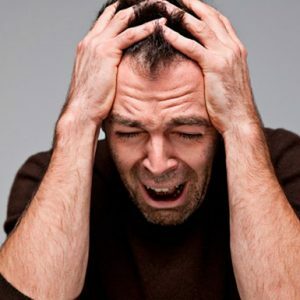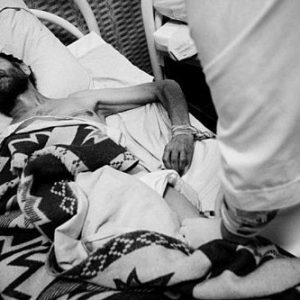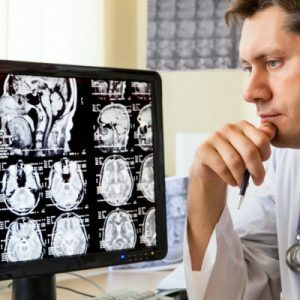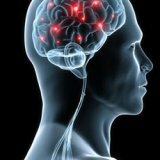Alcohol encephalopathy: symptoms, treatment and prognosis

The group of alcoholic encephalopathies include diseases included in the category of metalkogolnyh psychoses , ie alcoholism complications that occur with impaired metabolism, diseases of organs and other problems.The term "encephalopathy" means diseases that are based on damage to the brain tissue.
Clinical signs of this group of diseases are very diverse.Patients experience hallucinatory experiences, delusions, neurological complaints, mental changes, violations by internal organs.Our task is to understand the types of encephalopathies in more detail.
Contents: Which leads to the development of alcoholic encephalopathy Acute alcoholic encephalopathy Chronic alcoholic encephalopathy treatment of alcoholic encephalopathiesWhich leads to the development of alcoholic encephalopathies
Prolonged alcohol from 5 to 20 years, heavy binges, the use of surrogates, causes progressive destructionNerve cells and disruption of the basic functions of the central and peripheral nervous systems
.At the drinking person, alcoholic beverages cause vitamin deficiency( due to the destruction of the vitamins themselves and the violation of their absorption, assimilation).The process leads to thinning and fragility of the capillaries of the brain.As a result, a toxic brain edema can develop.Serious damage to other organs - the heart, the liver.This pathological "coil" of changes causes acute or chronic processes in the brain tissue.
Note: in women, alcoholic encephalopathy develops earlier than in men.Usually, 3-4 years after heavy alcoholic excesses, and sometimes after a year.
development of this problem is often preceded by "prodromal" period( ie, the step of precursors of disease).It can take several weeks, sometimes it takes up to a year.
It is characterized by:
- adynamic asthenia - constant tiredness, lethargy;
- expressed diarrheal disorders - an aversion to fatty foods, decreased appetite, diarrhea, abdominal pain, nausea, weight loss patients;
- sleep disorders.At night, there are chills, sweating, or vice versa - fever, chest pain, sensation of suffocation;
- numbness of hands and feet, trembling in the fingers, distortion of pronunciation of sounds, dizziness;
- vision is impaired and hearing is impaired.
Acute alcoholic encephalopathy
problem develops most often in men aged 30-50 years.Due to the fact that not everyone can turn for help, the disease often remains unrecognized for a long time.
Due to the severity of the course and duration of the process, acute alcoholic encephalopathies are divided into three subtypes:
-
 Acute alcoholic encephalopathy of Gaye-Wernicke. Flows in the form of delirium( mental disorder with a violation of consciousness).Patients experience meager illusory and hallucinatory experiences, anxiety and fearfulness, depressive-delirious thoughts( "silent delirium").In the daytime - stunned, apathetic stupor, in which patients all the time lie, uniformly answering questions.Upon examination, the patient is depleted, body temperature is increased, breathing is sharply increased to 40 per minute.Limbs tremble. In the analysis of blood - an excessive amount of leukocytes, observed oculomotor disorders, the intensity of the muscles of the trunk.In the study of cerebrospinal fluid - a sharp increase in pressure.Without assistance, death can occur in 2 weeks.Recovery begins in 3-5 weeks.
Acute alcoholic encephalopathy of Gaye-Wernicke. Flows in the form of delirium( mental disorder with a violation of consciousness).Patients experience meager illusory and hallucinatory experiences, anxiety and fearfulness, depressive-delirious thoughts( "silent delirium").In the daytime - stunned, apathetic stupor, in which patients all the time lie, uniformly answering questions.Upon examination, the patient is depleted, body temperature is increased, breathing is sharply increased to 40 per minute.Limbs tremble. In the analysis of blood - an excessive amount of leukocytes, observed oculomotor disorders, the intensity of the muscles of the trunk.In the study of cerebrospinal fluid - a sharp increase in pressure.Without assistance, death can occur in 2 weeks.Recovery begins in 3-5 weeks.
Note: the result of this encephalopathy is Korsakov's, or pseudoparalytic syndrome. - Mitigated form of acute alcoholic encephalopathy. is characterized by milder manifestations.Patients are irritable, easily excitable.The subdepressive state often develops.Sleep and appetite are disturbed, delirium is manifested at night.During the day sick are drowsy, hypochondriac.The disease lasts from 2 weeks to 3 months.After recovery, headaches, memory problems remain.
- A "super-fast" form of alcoholic encephalopathy. For clinical manifestations characterized by rapid development.The disease manifests itself in a sharp delirium, which in a few days passes into "delirium with muttering".The temperature rises to 40 g.Celsius.The patients are deaf, coma.The lethal outcome is 2-6 days.
Chronic alcoholic encephalopathies
In general( except Korsakovsky) - rare forms of psychosis.Some of them are not found in practice by every doctor.
Types of chronic alcoholic encephalopathies:
-
 Korsakovsky psychosis .In the special literature, including, as alcohol paralysis, polyneuric psychosis is described.It often develops in women 40-60 years.In most cases, the result is acute encephalopathy.Mental manifestations consist of a symptomatic triad - amnesia( loss of memory), disorientation, confabulation( memories of events that did not actually occur).Neurological complaints consist in the development of neuritis of the hands and feet, pronounced muscle atrophy.During treatment, the disease undergoes reverse development.
Korsakovsky psychosis .In the special literature, including, as alcohol paralysis, polyneuric psychosis is described.It often develops in women 40-60 years.In most cases, the result is acute encephalopathy.Mental manifestations consist of a symptomatic triad - amnesia( loss of memory), disorientation, confabulation( memories of events that did not actually occur).Neurological complaints consist in the development of neuritis of the hands and feet, pronounced muscle atrophy.During treatment, the disease undergoes reverse development. - Alcoholic pseudo-paralysis. Very rare.More common in men of mature age after severe delirium and encephalopathy of Gaye-Wernicke.In patients, the level of judgment decreases, knowledge is lost, the character is flattened and self-criticism is absent.Rough and vulgar humor, rudeness, self-aggrandizement in conversation.The appearance of patients is characteristic: trembling in the hands and muscles of the face, speech disorders, weakening the pupils' reaction to light.With active therapy, the condition improves.In the presence of concomitant diseases, the disease progresses.
Rare variants of chronic alcoholic encephalopathies:
- Alcoholic encephalopathy in the background of stenosis of the superior vena cava. occurs in alcoholics with cirrhosis of the liver.Often not recognized.With this form, the stunned state with manifestations of icterus of the skin and mucous membranes sharply develops.Mental changes are characterized by euphoric mood, stupid behavior, childish playfulness, apathy. Please note: the fingers of the hand are bent and unbend.Attacks are reversible and last no more than 1-2 days.
- Alcoholic encephalopathy of Marietaafa - Binyamy. The disease of Italian peasants who consumed a lot of red wines.The disease was recorded in France, USA, Argentina.Mostly men suffer.Against the background of progressive degradation delirium, deafness, expressed neurological problems( speech disorders, muscle tension, paralysis with sphincter disorders) develops.
- Morel's disease. Develops against the background of wine alcoholism.Manifestations resemble the encephalopathy of Gaie-Wernicke.The outcome is unfavorable.
- Alcoholic Pellagra. The cause of this encephalopathy is a deficiency of B and PP vitamins, which often accompanies the course of alcoholism.The onset of manifestations is pellagrogenic neurasthenia - headache, fatigue, stomatitis, intestinal tract lesions with severe diarrhea.Patients exhibit characteristic changes on the skin - red and brown spots on the hands, feet, neck and face.Alcoholic cerebellar atrophy.
- . In the clinic of this form, there are imbalances, unstable walking.
 Among the chronic alcoholic encephalopathies there are variants with a picture of beriberi( against the background of vitamin B1 deficiency), with retrobulbar neuritis( with central and side vision disturbances, normal color rendition), with central necrosis of the bridge( pronounced neurologic manifestations with a distinctive sign -Insensitivity to pain).
Among the chronic alcoholic encephalopathies there are variants with a picture of beriberi( against the background of vitamin B1 deficiency), with retrobulbar neuritis( with central and side vision disturbances, normal color rendition), with central necrosis of the bridge( pronounced neurologic manifestations with a distinctive sign -Insensitivity to pain).
Diagnosis of alcoholic encephalopathies is based on manifestations of the disease, computed tomography, MRI, encephalography, rheography, angiography, and other methods.
Treatment of alcoholic encephalopathies
All types of alcoholic encephalopathy are treated with the use of large doses of vitamin B1( Thiamine).This substance is considered a pathogenetic therapy tool number 1, especially with encephalopathy Gaia-Wernicke.
Important: the use of this drug in shock doses significantly reduces the mortality rate and overall prognosis.
Thiamine bromide is administered separately in the muscle or in combination with other vitamins.In severe cases, it can be administered intravenously, as part of detoxification droppers.
To prevent cerebral edema and seizures, Magnesia injections are administered intramuscularly with Novocaine solution for pain relief, or with Glucose intravenously.
For symptomatic indications, Cordialin is prescribed( with a drop in pressure), Lobelin and Cititon - with weakened breathing.
In severe cases, hormone therapy is carried out - Prednisolone, Dexamethasone.
Important drugs in the treatment of encephalopathies are neuroleptics that take away the manifestations of hallucinations, delusions.
Nootropics are an indispensable tool in the recovery of brain functions.
Korsakov psychosis gives psychostimulants - Caffeine, Sydnokarb.
Active alcohol treatment is conducted.
Non-drug types of treatment are effective: acupuncture, electrotherapy, traditional medicine.
Prognosis depends on the form of alcoholic encephalopathy and treatment.
Alexander Lotin, medical reviewer



